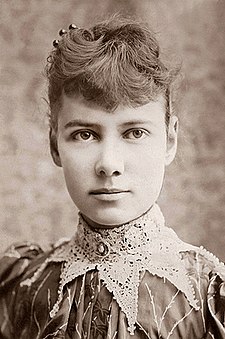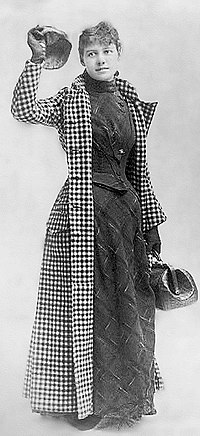Nellie Bly
From Wikipedia, the free encyclopedia
| Nellie Bly | |
 Nellie Bly in 1890
|
|
| Born | May 5, 1864 Cochran's Mills, Armstrong County, Pennsylvania, USA |
|---|---|
| Died | January 27, 1922 (aged 57) New York City, USA |
| Occupation | Journalist, author |
| Spouse(s) | Robert Seaman |
Nellie Bly (May 5, 1864[1] – January 27, 1922) was an American journalist, author, industrialist, and charity worker. She is most famous for an undercover exposé in which she faked insanity to study a mental institution from within. She is also well-known for her record-breaking trip around the world.
Born Elizabeth Jane Cochran in Cochran's Mills, Armstrong County, Pennsylvania, 40 miles northeast of Pittsburgh, she was nicknamed "Pink" for wearing that color as a child. Her father, a wealthy former associate justice, died when she was six. Her mother remarried three years later, but sued for divorce when Cochran was 14. Cochran testified in court against her drunken, violent stepfather. As a teenager she changed her surname to Cochrane, apparently adding the "e" for sophistication.[2] She attended boarding school for one term, but dropped out due to a lack of funds.
In 1880, Cochran and her family moved to Pittsburgh.one day she read an articale about "what girls are good for", she was furious. She wrote a letter to the dispatch newspaper telling them whet she thought of it, and the manager sent her a letter back telling her he was impressed by the letter. Female newspaper writers at that time customarily used pen names, and for Cochran the editor chose "Nellie Bly", a misspelling of the title character in the popular song "Nelly Bly" by Stephen Foster.
Bly focused her early work for the Dispatch on the plight of working women, writing a series of investigative articles on female factory workers. But editorial pressure pushed her to the women's pages to cover fashion, society, and gardening, the usual role for female journalists of the day. Dissatisfied with these duties, she took the initiative and traveled to Mexico to serve as a foreign correspondent.
Then 21, she spent nearly half a year reporting the lives and customs of the Mexican people; her dispatches were later published in book form as Six Months in Mexico. In one report, she protested the imprisonment of a local journalist for criticizing the Mexican government, then a dictatorship under Porfirio Díaz. When Mexican authorities learned of Bly's report, they threatened her with arrest, prompting her to leave the country. Safely home, she denounced Díaz as a tyrannical czar suppressing the Mexican people and controlling the press.
Contents |
[edit] Asylum exposé
Burdened again with theater and arts reporting, Bly left the Pittsburgh Dispatch in 1887 for New York City. Penniless after four months, she talked her way into the offices of Joseph Pulitzer's newspaper, the New York World, and took an undercover assignment for which she agreed to feign insanity to investigate reports of brutality and neglect at the Women's Lunatic Asylum on Blackwell's Island.
After a night of practicing deranged expressions in front of a mirror, she checked into a working-class boardinghouse. She refused to go to bed, telling the boarders that she was afraid of them and that they looked crazy. They soon decided that she was crazy, and the next morning summoned the police. Taken to a courtroom, she pretended to have amnesia. The judge concluded she had been drugged.
She was then examined by several doctors, who all declared her to be insane. "Positively demented," said one, "I consider it a hopeless case. She needs to be put where someone will take care of her."[3] The head of the insane pavilion at Bellevue Hospital pronounced her "undoubtedly insane". The case of the "pretty crazy girl" attracted media attention: "Who Is This Insane Girl?" asked the New York Sun. The New York Times wrote of the "mysterious waif" with the "wild, hunted look in her eyes", and her desperate cry: "I can't remember, I can't remember."[4]
Committed to the asylum, Bly experienced its conditions firsthand. The food — gruel broth, spoiled meat, bread that was little more than dried dough — she found inedible. The inmates were made to sit for much of each day on hard benches with scant protection from the cold. The bathwater was frigid, and buckets of it were poured over their heads. The nurses were rude and abusive, telling the patients to shut up and beating them if they did not. Speaking with her fellow residents, Bly was convinced that some were as sane as she was. On the effect of her experiences, she wrote:
"What, excepting torture, would produce insanity quicker than this treatment? Here is a class of women sent to be cured. I would like the expert physicians who are condemning me for my action, which has proven their ability, to take a perfectly sane and healthy woman, shut her up and make her sit from 6 a.m. until 8 p.m. on straight-back benches, do not allow her to talk or move during these hours, give her no reading and let her know nothing of the world or its doings, give her bad food and harsh treatment, and see how long it will take to make her insane. Two months would make her a mental and physical wreck."[3]
After ten days, Bly was released from the asylum at The World's behest. Her report, later published in book form as Ten Days in a Mad-House, caused a sensation and brought her lasting fame. While embarrassed physicians and staff fumbled to explain how so many professionals had been fooled, a grand jury launched its own investigation into conditions at the asylum, inviting Bly to assist. The jury's report recommended the changes she had proposed, and its call for increased funds for care of the insane prompted an $850,000 increase in the budget of the Department of Public Charities and Corrections.
[edit] Around the world
In 1888, Nellie suggested to her editor at the New York World that she take a trip around the world, mimicking Jules Verne's book Around the World in Eighty Days. A year later, on November 14, 1889 she left New York on her 24,899-mile journey.
"Seventy-two days, six hours, eleven minutes and fourteen seconds after her Hoboken departure" (January 25, 1890) Nellie arrived in New York. At the time this was a world record for circling the earth, though it was bettered a few months later by George Francis Train, who completed the journey in 67 days.
On her travels around the world, she went through England, France, the home of Jules Verne, Brindisi, the Suez Canal, Colombo, Ceylon, Hong Kong, and Japan.
[edit] Later years
Nellie Bly married millionaire manufacturer Robert Seaman in 1894, who at 72 was 42 years her senior. She retired from journalism, and became the president of the Iron Clad Manufacturing Co., which made steel containers such as milk cans and boilers. In 1904 she invented and patented[citation needed] the steel barrel that was the model for the 55-gallon oil drum still in widespread use in the United States. Her husband died that year. For a time she was one of the leading female industrialists in the United States, but mismanagement forced her into bankruptcy. Forced back into reporting, she covered such events as women's suffrage convention in 1913, and stories on Europe's Eastern Front during World War I.[5]

In 1916 Nellie was given a baby boy whose mother requested Nellie look after him and see that he become adopted. The child was illegitimate and difficult to place since he was half Japanese. He spent the next six years in an orphanage run by the Church For All Nations[clarification needed] in Manhattan.
As Nellie became ill towards the end of her life she requested her niece, Beatrice Brown, look after the boy and several other babies in whom she had become interested. Her interest in orphanages may have been part of her ongoing efforts to improve the social organizations of the day.
She died of pneumonia at St. Mark's Hospital in New York City in 1922, at age 57 and was interred in a modest grave at Woodlawn Cemetery in Bronx, NY.
[edit] Legacy
- Bly was the subject of a 1946 Broadway musical by Johnny Burke and Jimmy Van Heusen.[6] She was also the subject of a musical entitled "Stunt Girl" by Tony Nominee Peter Kellogg and David Friedman.
- The Nellie Bly Amusement Park in Brooklyn, New York City, is named after her, taking as its theme Around the World in Eighty Days. The park recently reopened under new management.
- Nellie Bly is a character in the computer video game Worlds of Ultima: Martian Dreams.
- Nellie Bly was one of four journalists honored with a U.S postage stamp in a "Women in Journalism" set in 2002.[7]
- She was the subject of a musical play performed at the Albany Civic Theater.
- From early in the Twentieth Century until 1961, the Pennsylvania Railroad operated a parlor-car only express train between New York and Atlantic City that bore the name, "Nellie Bly."
- Nellie Bly's investigation of the Blackwell's Island insane asylum is dramatized in the 4D experience shown in the Annenberg Theater at the new Newseum in Washington, DC, which opened in 2008.
- The comics and other versions of the character of Lois Lane has Nellie Bly as her idol and role model for lady journalist.[citation needed]
- Provides the hinge of a scene in which Abbey Bartlet declaims Bly's achievements to President Josiah Bartlet in The West Wing episode "And it's surely to their credit". [8]
[edit] References
- Bly, Nellie (1887). Ten Days in a Mad-House.
- Kroeger, Brooke (1994). Nellie Bly: Daredevil, Reporter, Feminist.
- Affidavit of Beatrice K. Brown; Surrogates Court, Kings County (1922)
[edit] Notes
- ^ Kroeger 1994 reports (p. 529) that although a birth year of 1867 was deduced from the age Bly claimed to be at the height of her popularity, her baptismal record confirms 1864.
- ^ Kroeger 1994, p. 25.
- ^ a b Bly 1887.
- ^ Kroeger 1994, pp. 91–92.
- ^ The remarkable Nellie Bly, inventor of the metal oil drum, Petroleum Age, 12/2006, p.5.
- ^ "After the poorly received Nellie Bly (1946) ... [stage director Edgar J.] MacGregor retired.", musicals101.com
- ^ USPS Press Release (September 14, 2002), Four Accomplished Journalists Honored on U.S. Postage Stamps, usps.com
- ^ http://www.twiztv.com/cgi-bin/transcript.cgi?episode=http://dmca.free.fr/scripts/thewestwing/season2/thewestwing-205.txt
[edit] See also
- Miss Nellie Bly Special
- Ten Days in a Mad-House
- Around the World in Seventy-Two Days
- Women in journalism and media professions
- Undercover journalism
- Winifred Bonfils
- Bicho de Sete Cabeças
[edit] External links
| Wikimedia Commons has media related to: Nellie Bly |
- Ten Days in a Mad-House, and other early investigative reports by Nellie Bly
- Nellie Bly Memorial at Find A Grave
- New York Times: Nellie Bly, Journalist, Dies of Pneumonia
- An account of Bly's trip around the world
- Nellie Bly's Book: Around the World in Seventy-Two Days
- American Experience | Around The World In 72 Days, a documentary about Bly's trip around the world.


